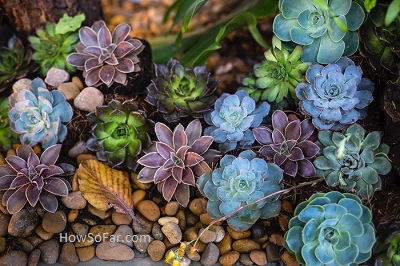Succulents are plants native to dry, rocky areas, so they have evolved the ability to store enough moisture in their leaves and stems to survive long periods without watering. Easy care, interesting appearance, and variety of species have made these plants popular both in home decor and in decorating the yard.

Types of Succulents
For many, succulents are associated with cacti. But in fact, the cactus family is only a part of those who are part of this diverse group of plants.
According to the principle of moisture accumulation, they can be divided into two main parts:
- Leafy (for example, haworthia, young, Kalanchoe);
- Stem (for example, cereus, lithops).
Let’s take a closer look at succulents that can decorate your apartment or yard.
Indoor succulents
Greenery in the decor of the rooms is a stylish detail that gives comfort to the house. Succulents are great for this purpose, as they are quite easy to care for and provide many options for creativity:
- Unusual compositions in the aquarium for the living room;
- Compact succulents in the bathroom;
- Pots with hanging succulents for the kitchen or terrace.
What variety to choose from?
Haworthia
You have probably come across this kind of miniature succulent that looks like tentacles more than once. The leaves of haworthia are predominantly dark green and form a rosette, some species have white patches on the surface of the leaves.
It is believed that these plants can attract good luck and positive energy.
Lithops (living stones)
Stem succulents resembling stones on the outside. With them, you can create very interesting compositions, because their top can have a fairly diverse color.
Despite the outward minimalism, lithops are flowering succulents! Bright flowers of yellow, white, or cream shade appear most often in autumn, in September or October.
Echeveria (stone rose)
Echeveria has small juicy leaves that look like a rose. Therefore, it received its second name. This also applies to flowering succulents: in summer, under favorable conditions, pleases with red buds.

Fat woman (krasula, money tree)
This is probably one of the most common indoor succulents. The fat woman gained fame and love due to her ease of care and beautiful appearance. If you set a goal, you can form a stylish tree out of it.
Argyroderma (Argyroderma)
Like lithops, this succulent looks like rocks. The leaves are turned towards each other, as a result of which it seems that the plant has “split” in half. Likes sandy and rocky soil.
Despite the modest appearance, argyroderma is a flowering succulent. The color palette includes white, orange, pink, yellow, and purple. Pots for this indoor plant should be shallow, with good drainage, because the rooting of the succulent is shallow, in the upper layers.
Outdoor succulents
Succulents can be combined into unusual compositions for the landscape design of your backyard. Stylish and compact compositions in pots or boxes, alpine slides with ground cover creeping succulents – it depends on your preferences. The main thing is to make sure that the plants have sufficient lighting and do not suffer from flooding after heavy rains.
Consideration should be given to drainage and appropriate mineral composition before planting outdoors (ordinary soil may not be suitable). And, of course, check whether the frost-resistant type of succulents was picked up enough. Otherwise, it is better to place the compositions in pots, which can be transferred to the house during the cold season.
Rejuvenated roofing
Sempervivum tectorum is one of the varieties of the rock rose. This ground covers succulent needs at least 1 cm of soil to take root.
Once in the Mediterranean countries, it was planted on the roofs with the hope that this would protect against lightning. It can bloom, adapts well to our climatic conditions, and withstands temperatures as low as -12. In garden compositions, you can plant a succulent to spread a carpet or decorate the gaps between roses with stones.

Stonecrop (sedum, hare cabbage)
Variations in the name of this herbaceous succulent are associated with the medicinal properties of the plant, which was used for cleansing and soothing. It has a very wide variety of species that differ in leaf color, flowering, and growth direction. But for most types of stonecrop, fleshy stems are characteristic.
Ampel succulents
Ampelous, they are hanging or creeping, succulents are varieties that have long stems and hang beautifully from the pot. Often they originated from vines, and look good both in home decor and in landscaping a personal plot.
Krasula marnieriana (Crassula marnieriana)
Ampelous succulent, which can be grown both in open ground and in a pot. The stems are densely covered with fleshy leaves. Loves sunshine throughout the year.
Stonecrop Morgan
A variety of sedum, which looks stylish in a hanging planter. Its stems can reach 1 m in length. The leaves are located close to each other and from a distance look like grapes.
When the air temperature drops below 4 degrees, the risk of plant death increases. If you use a succulent for yard decor in the summer, you should return it to the house in the fall.
Stonecrop Morgan is a flowering succulent. But for this, he needs a sufficient level of lighting.
Rawley the godson
This succulent vine looks quite stylish in a planter, especially when it grows luxuriantly. The flexible stem is abundantly covered with juicy leaves, which are more like berries or balls. Needs a lot of light, but the sun’s rays shouldn’t be direct. When watering Rowley’s ragwort, avoid getting moisture on the leaves, because traces will remain.
How to propagate succulents
Succulents can be germinated from seeds, but vegetative methods are simpler and faster: cuttings and propagation by leaves. We will consider them in more detail.
Interesting on the topic 10 Easy DIY Spring Home Decoration Ideas That Will Brighten Up Your Space
Autumn and winter are not very suitable for propagating succulents at home, it is better to do this in spring and summer.
Reproduction of Succulents
One of the simplest methods that even beginners can do. To obtain a new plant, a leaf is separated, roots are germinated from it and a new plant is planted.
- Before cutting the leaf, it is advisable to sharpen and disinfect the knife well.
- For propagation, the leaves are used as healthy as possible: dense, without cuts, without spots.
- After you cut a leaf for the propagation of a succulent, let the cut point dry for 2-3 days. Otherwise, there is a risk that it will begin to rot and the plant will die.
- When you place the leaf in the soil, do it at an angle to speed up the germination process.
- The soil should be drained, with coal and river sand.
- After placing the shoot in the soil, care must be taken to ensure sufficient moisture. To do this, distilled water should be sprayed from a spray bottle over the surface of the earth.
Cuttings of succulents
Succulents can be propagated by cuttings (the part of the plant containing the leaves and stem). After the cut, they must be dried (up to seven days), and the mother plant must be treated with crushed coal at the place of separation.
The fat woman can be rooted in water (carefully make sure that the lower part of the handle does not touch the bottom of the container, and rot does not appear on the cut).
Cuttings should be planted in a small vessel, for example, ordinary glass is quite suitable.
How to Care for Succulents
Succulents need diffused light and moderate watering. But an excess of moisture and darkness for these plants, like kryptonite for Superman – have a devastating effect.
Remember the main rule, you can delve into the details of how to care for succulents:
- Soil for succulents should be chosen mineral, sandy. But organic matter and excessive moisture can be detrimental to these plants. Therefore, when choosing soil for succulents, you should refrain from mixtures containing a lot of peat.
- It is important to provide good drainage and loose soil.
- When choosing a pot, you can give freedom to the imagination. Compositions of succulents grow well both in ordinary ceramic and plastic containers and in glass aquariums and even vertically in wooden boxes. In the latter case, it is necessary to add a metal mesh to strengthen the roots.
- Before transplanting a plant into new soil, it should be heated in the oven for disinfection.
To avoid the appearance of rot, a layer of fine expanded clay should be added to the roots during transplantation. - It is necessary to water succulents taking into account the season: in spring – once a week, in summer – twice a month, in autumn and winter – once a month (except for cacti, which should not be watered at all from October to April).
- Watering succulents is also affected by temperature and amount of light. When it is too cold, too hot, or not enough light, it is advisable to reduce watering. The turgor (elasticity) of the leaves will serve as a clue. If there are no visible wrinkles, and the succulent is sufficiently resilient, then there is no urgent need for watering.
- Feeding succulents should also not be excessive. The fertilizer should contain potassium and nitrogen, and it is enough to feed the plants in the summer once a month.
- In the spring, plants can be transplanted: once a year if the succulents are less than three years old, and then once every 4-5 years. Before placing them in new soil, the roots must be allowed to dry out.
- Rot due to overwatering is one of the most common causes of plant loss. If you see signs of it on the leaves or stems of a succulent, you should cut them off to a healthy part.
- Since the homeland of succulents had quite stressful conditions, they can be reproduced to reveal the richness of plant color. Temperature changes, excess light, and moisture deficiency stimulate the appearance of interesting shades on the leaves, and not just the standard green.
Succulents (at least outdoors, at least indoors) do not require complex care and excessive attention. Instead, they give a lot of aesthetic pleasure. Beautiful compositions of rare succulents in aquariums, unusual combinations of street varieties in alpine hills and flower beds, stylish imperious variations for yard decor – every hostess will find an option for her inspiration. By the way, share in the comments if you already have experience in caring for and propagating these beautiful plants. And do not forget to tell us which type of succulents you prefer.
FAQs:
1. Why dry cuttings and leaves of succulents?
First, to avoid the appearance of rot. Secondly, when the top of the plant loses moisture, it stimulates the formation of succulent roots.
2. What is a succulent plant?
A succulent plant is a plant that stores water in its leaves, stems, and roots. They have adapted to survive in dry and arid environments.
3. What are some popular succulent plant varieties?
Some popular succulent plant varieties include Echeveria, Crassula, Sedum, Aloe, and Haworth.
4. What kind of soil should I use for my succulent garden?
Succulent plants require well-draining soil that is specifically formulated for succulents. You can find special succulent soil mixes at your local garden center or online.
5. How often should I water my succulent garden?
Succulent plants do not require frequent watering. In general, you should water them thoroughly but infrequently. How often you should water your succulent garden depends on factors such as climate, humidity, and soil drainage.



